Appendix 2a: Illustrative Games 1
The first game is a casual game between Morphy and Judge Meek, played during the First American Chess Congress. The moves are from Tartakower and DuMont, 500 Master Games of Chess, Dover. It's also in Sergeant's collection of Morphy's games where it's listed as a casual game. Only the first 12 moves are known. See Appendix 1 if you need some help with descriptive notation.
Morphy vs Meek, New York 1857
Casual Game
| 1. | P-K4 | P-K3 |
| 2. | P-Q4 | P-QB4 |
| 3. | P-Q5 | P-K4 |
| 4. | P-KB4 | P-Q3 |
| 5. | N-KB3 | B-N5 |
Diagram 1
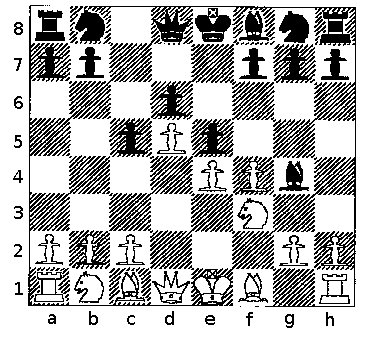
Position after 5 .... B-N5
White Controls 54 squares Black Controls 51 squares
Black is getting ready to make a plausible and instructive, but bad sixth move. It can be criticized on the grounds that black gives up his good bishop, that the bishop has already moved once, that black is neglecting his development, and half a dozen others. A different way of looking at it is that it gives away several squares by bringing white's queen into the game. Black will be lost in just a few moves.
| 6. | PxP | BxN |
| 7. | QxB | PxP |
White is now up 12 squares in just seven moves.
| 8. | B-N5+ | N-Q2 |
| 9. | N-B3 | N-B3 |
| 10. | B-N5 | B-K2 |
Diagram 2
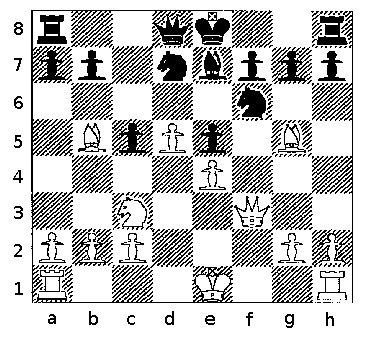
Position after 10 .... B-K2
White Controls 65 squares. Black Controls 53 squares
| 11. | P-Q6 | BxP |
| 12. | 0-0-0 |
This is as far as the score goes
12 .... Q-N3 (suggestion of Tartakower and DuMont to explore the possibilities)
Diagram 3
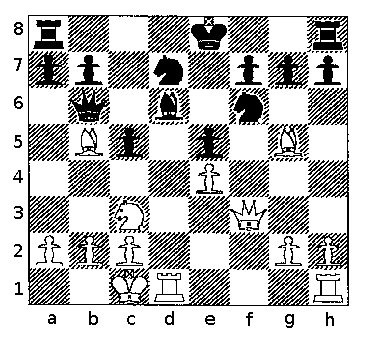
Position after T & D's suggestion 12 .... Q-N3
White Controls 69 squares Black Controls 55 squares. White is up 14 squares and has a won game.
No one knows the remaining moves, or even if the game continued past White's twelfth move. Black is lost. Tartakower and DuMont suggest 12 .... Q-N3 and a couple of variations to show why.
Analysis 1
| 13. | BxN | PxB |
| 14. | QxP | White Wins |
Diagram 4
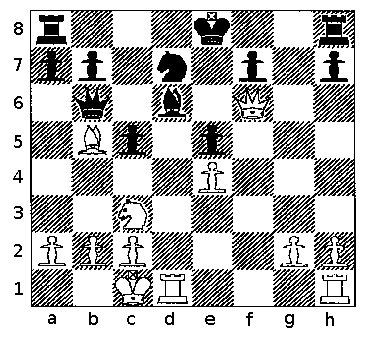
After 14 QxP in T and D's Analysis 1
White Controls 63 squares Black Controls 46 squares A computer can find even better for White, but that's gilding the lily.
Black is just as lost if he retreats the bishop on move 11 instead of capturing the pawn. T and D suggest that if 11 .... B-B1 then 12 N-Q5 and if 12 .... Q-R4+ then 13 B-Q2 wins Black's Queen. What else is there for Black? White is threatening to play N-B7+ winning Black's Queen or BxN followed by NxP+. Note how the pin on Black's queen knight makes it worthless. Pins are another of the standard tactical tricks which are discussed in the Appendix on tactics.
Analysis 2
| 11. | .... | B-B1 |
| 12. | N-Q5 | See Diagram 5 |
| 12. | .... | Q-R4+ |
| 13. | B-Q2 | Any |
And Black loses his queen.
Or...
| 12. | .... | R-B1 |
| 13. | BxN | and |
| 14. | NxP+ |
Note the smothered mate threats. Smothered mates and other typical mating patterns are discussed in the Appendix on tactics.
Diagram 5
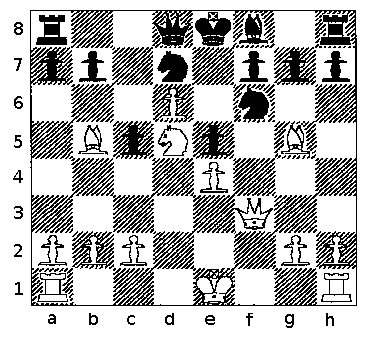
Position which occurs if Black moves 11 .... B-B1 and White responds with 12 N-Q5 (discussed above).
Addendum to Morphy - Meek, New York 1857
Who was Meek? He doesn't seem to have been a very good player, but he was an intelligent and successful man who loved the game. We should remember him for more than getting squashed like a bug.
Alexander Beaufort Meek was born in 1814 in Mobile, Alabama, and doesn't his name just roll off your tongue? Nineteen years later he graduated first in his class from the University of Alabama and eventually became a nationally successful politician and a judge. He played in America's first major tournament, New York 1857.
I was curious about the Beaufort part of his name, thinking of another Beau, Pierre Gustave Toutant Beauregard, better known as General. I found a few on-line sources which, hopefully without human intervention, translate Beaufort Meek as "Beautiful Fortress" Meek.
Morphy's father was a judge and Paul himself prepared for a legal career at St. Joseph's College near Mobile. Meek met Morphy there in 1855, and he probably took a special interest in the younger player's career. His casual loss to Morphy two years later shouldn't be held against him, because people played like Meek before Steinitz came along. I can empathize with Meek, because my own first chess book was Sergeant's edition of Morphy's games, and I still wish now, as I did then, that I could play like Morphy.
I certainly wish I could play against judges the way Morphy did. I once played a tournament game against a judge whom I outranked by 300 points. I caught him in the Noah's Ark trap, but this only made him mad. When he realized what was happening, he sacrificed his bishop to get my king into the middle of the board and beat me badly. Chess is a lot harder than it looks.
Here's a Meek game which serves his memory better than his famous loss to Morphy. It's short, instructive, and pretty.
Diagram 6
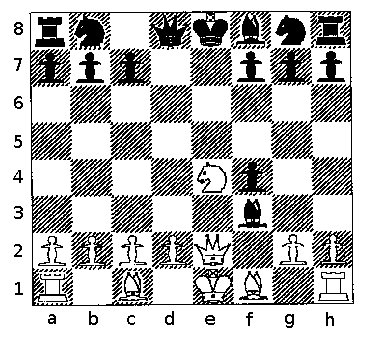
The initial moves are:
| 1. | P-K4 | P-K4 |
| 2. | P-KB4 | PxP |
| 3. | N-KB3 | P-Q4 |
| 4. | N-B3 | PxP |
| 5. | NxP | B-KN5 |
| 6. | Q-K2 | BxN |
Meek vs Anonymous
Position after 6 .... Bxf3
Meek played 7 Nf6 double check and mate, probably to his opponent's great surprise.
Where did black go wrong? Tactically, he missed the double check, which is one of the most powerful of all the little tricks that a good player knows. Remember, when there's a double check the king must move - there's no other way to get out of check. There's no way to block both checks or to capture both checking pieces simultaneously and checkmate often follows.
Strategically, capturing the knight was a real boner, a word I learned from Louis Halliwell S.J., an elderly Jesuit priest who ran the bookstore and the chess club at Cranwell, a prep school long since shuttered. Boner is a good word. It describes the kind of move a bone head would make, and chess players or not, we all make plenty of them.
Fr. Halliwell's first advice to me would also have done both Judge Meek and his opponent a world of good.
I had just begun high school as a day student, and came back one night with a couple of friends to go to a rally, which was canceled. This left us with nothing to do for the next couple of hours except wait for someone's mother to pick us up. We happened to be standing outside the chess club. I barely knew how the pieces moved but it looked warmer in there than it was outdoors, so I became a chess player.
Here's the advice. After chess club, I rejoined my friends and who should come by but Fr. Halliwell. He recognized me, congratulated me on my win, and pointed out that I had been too slow in developing my pieces. I don't remember the moves, but I do remember this. He sang, and made me sing along with him, in front of my friends, "Bring out your knights and bishops. Bring out your knights and bishops." I was mortified, but to this day out come the knights and bishops. Fr. Halliwell was a good man who loved chess, and I learned much from him. And so can you.
Neither Meek in his game against Morphy, nor Anonymous in his game against Meek seem to know how important it is to develop the pieces and avoid wasting moves. Bring out your knights and bishops. Both players used a developed piece to capture an opponent's developed piece - fine. But the opponent recaptured with an undeveloped piece (the queen) which now became developed, leaving him with a net gain in development. Don't do this unless you get something in return, and in an open position it had better be a lot.
I can't remember where (Edward Lasker ?), but I read that a sign you are winning is that the position on the board looks like you have, in one way or another, been able to make more moves than your opponent. Here's an example.
| 1. | e4 | e6 |
| 2. | Nf3 | Nc6 |
| 3. | Bc4 | e5 |
Diagram 7
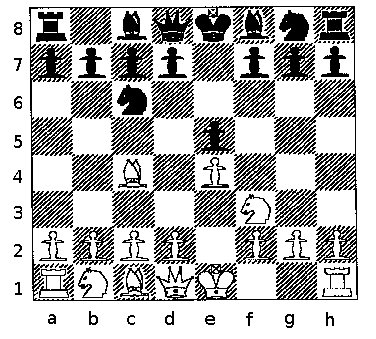
This is a very simple example of giving away a move for free. The position might look familiar, but it isn't. Normally, Black would be on the move, but here it's White's turn. Black has made a bad mistake by moving his king pawn twice and has thrown away one full move. If it occurred several moves into the game, it would be much harder to notice, and much harder to avoid.
If Black were square counting, he would have ruled out e5 which doesn't increase Black's count at all, and increases White's count by opening up f7 to the bishop. Let's look at three plausible alternatives - Nf6, Bc5, and d5.
Nf6 increases Black's count by six squares. The knight goes from 3 to 8 and the king's rook picks up 1. The problem is that white can play e5 and chase the knight around. How about Bc5?
Bc5 increases Black's count by 4 squares. The bishop keeps his original diagonal and picks up new squares on the b3-f2 diagonal. The g7 square goes, but the a7 square makes up for it. Again, the problem is that white can go after the bishop, this time with d4, and white picks up additional squares for his queen and queen's bishop. This leaves d5.
When Black plays 3 ... d5, he encourages White to play e4 x d5, if for no other reason than to prevent d5 x e4. Black's game doesn't look bad. He will get his pawn back and both bishops will have open diagonals (squares), and after they move, additional diagonals with additional squares.
Now let's take this concept of extra moves one step further. What if the rules were changed so that White always made one move at a time, but Black got additional moves. After white's first move, let's say that Black made one move, but after White's second move Black could make two moves, after White's third Black could make three, and so on. How long would such a game last?
| 1. | e4 | e5 |
No surprises so far.
| 2. | Nf3 | ... |
But this loses. Of course, everything else loses too.
| 2 | .... | d5 and Bg4 |
Diagram 8
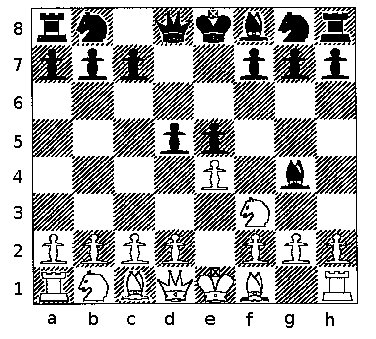
Position after 2 .... d5 and .... Bg4
3. Resigns 0 - 1
White's Queen is doomed. Black will get three moves in a row, and that's all it takes.
And this is why you don't want to give moves away.
Appendix 2b continues the discussion with the Blackburne - Lasker game.
Return to Main Article - How to Play Chess Well
Continue to Appendix 2b
Return to Chess Main
